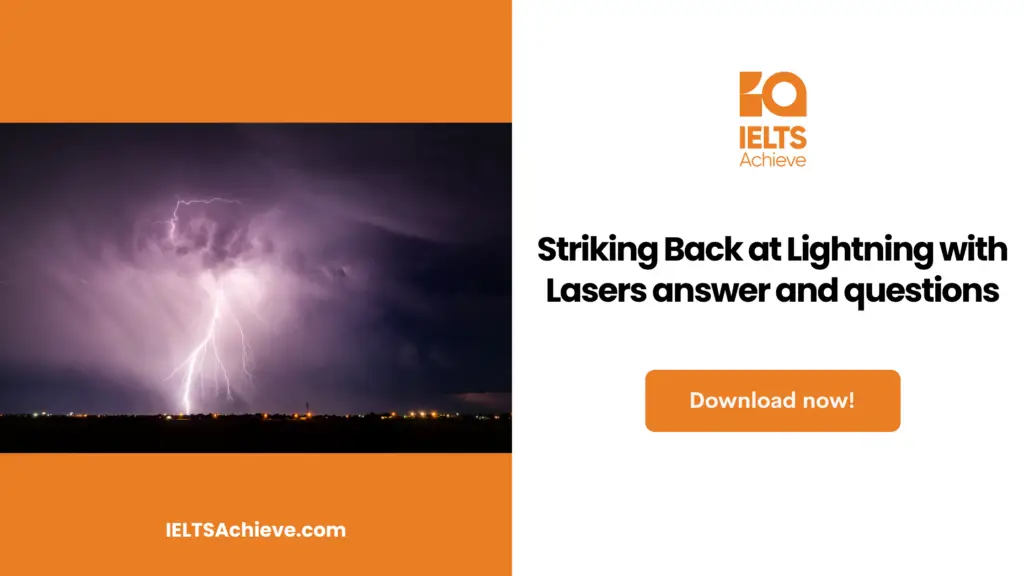The Blog post contains the following IELTS Reading Questions:
- IELTS Reading Multiple Choice Questions
- IELTS Reading Sentence Completion
- IELTS Reading Summary Completion
- IELTS Reading Yes/No/Not Given
Stay informed and prepared for success – Explore our comprehensive Reading Test Info page to get valuable insights, exam format details, and expert tips for mastering the IELTS Reading section.
IELTS Reading Passage – Striking back at Lightning with lasers

Striking Back at Lightning with Lasers
A. The weather is rarely more spectacular than when a thunderstorm strikes. Each year throughout the United States alone, its electrical fury ends up killing or severely injuring nearly 500 people. When the sky begins to darken, a relaxing round of golf could morph into a terrifying gamble with death. If the golfer is alone and out in the open, they could be the most vulnerable target for a lightning bolt. Additionally, there is damage to the property. Destruction done by lightning costs American electricity organizations more than $100 million every year.
B. However, researchers in both the United States and Japan intend to strike back. They have already conducted tests in laboratories to evaluate how to reduce the strength of thunderstorms, and thus this winter they will face real storms while equipped with an array of lasers that they will be aiming at the sky to discharge thunderclouds before lightning strikes.
C. The concept of manipulating storm clouds to fire their lightning is not new. In the early 1960s, scientists experimented with launching rockets with trailing cables into thunderclouds in an attempt to create an ideal discharge route for the massive electric charges that these clouds produce. The method is still used today at the test site in Florida, operated by the University of Florida with assistance from the California-based Electrical Power Research Institute (EPRI). EPRI, which is financed by power companies, is researching ways to safeguard the United States power grid against lightning strikes. According to Ralph Bernstein, manager of lightning plans at EPRI, they can utilize rockets to compel the lightning to hit wherever we want it to. The rocket site provides accurate measurements of lightning voltages, allowing engineers to evaluate how electrical equipment holds up under extreme conditions.
Bad Behaviour
D. However, rockets are ideal for research but cannot offer the protection from lightning everyone wants. The failure rate of the rockets, which cost approximately $1,200 per piece and can only be launched at a limited frequency, is nearly 40%. The circumstances often do not turn out as anticipated, despite triggering lightning. According to Bernstein, lightning does not always behave properly. There are times when it will grasp a branch and venture into an area where it is not intended to go.
E. Besides, who would wish to launch rockets into a populated place? According to University of New Mexico professor Jean-Claude Diels, whatever goes up must come down. Diels is heading an EPRI-supported experiment and attempting to utilize lasers to discharge lightning safely. Safety is indeed a basic criterion because no one wants to endanger themselves or their expensive equipment. A promising technology is only beginning to emerge from the laboratory after an initial investment of about $500,000.
F. The concept first emerged roughly 20 years ago, when incredibly powerful lasers started to demonstrate their capability to remove electrons from atoms and produce ions. Before the electric field is strong enough to cause the air to break down by striking down in an unmanageable flash, lightning could be guided to Earth by creating a line of ionization in the air that extends up to the storm cloud. The laser should not be pointed directly at the clouds to prevent it from being struck too. Instead, it would be pointed at a mirror, from which it would be aimed into the sky. The installation of lightning conductors near the mirrors would protect them. The cloud-zapper (gun) would ideally be affordable enough to be placed around all-important power stations and portable enough to be carried to international sporting events to shoot up at developing stormy clouds.
A Stumbling Block
G. Though there is still a major stumbling block to overcome, the laser is a monster that occupies an entire room; it is not handy or portable. Diels is attempting to reduce the size and claims that a laser the size of a small table is coming soon. He intends to test this more controllable technique on real thunderclouds next summer.
H. According to Bernstein, the power stations are displaying a significant interest in Diels’ approach. However, they have not yet been able to raise the $5 million that EPRI anticipates would be required to establish a commercial system by making the lasers quite small and inexpensive. Bernstein continues to add that he can’t claim he has money yet, but he is still working on it. He believes the upcoming field tests will be a turning point, and he is expecting positive results. If everything goes according to plan, Bernstein predicts there will be an avalanche of interest and support. He anticipates that someday the loud-zappers will cost $50,000 to $100,000 each.
I. Other scientists might also benefit from it. Materials scientists could understand what happens when strong currents clash with the matter if they had a lightning “switch” in their control. Diels also expects to see the development of “interactive meteorology,” which would enable both weather forecasting and weather control. He adds that we might have an impact on the weather if we can discharge clouds.
J. Diels suggests that humans might be able to deal with other meteorological hazards. He states that they thought they could prevent hail by causing lightning. It is believed that thunder, a shock wave caused by a lightning flash, is what initiates storms and their typical torrential rain. Large hailstones that could be dangerous for crops could potentially not form if a laser thunder factory removes the moisture from the clouds. Hopefully, laser-wielding researchers will be able to retaliate for the first time this winter when storm clouds accumulate.
Unlock your full potential in the IELTS Reading section – Visit our IELTS Reading Practice Question Answer page now!
Recommended Questions:
Renewable Energy IELTS Reading Question with Answer
Striking Back at Lightning with Lasers IELTS Reading Questions
Questions 1 – 3
Choose the correct letter, A, B, C or D. Write the correct letter in boxes 1 – 3 on your answer sheet.
1. As per the passage description, each year lightning ….
- has mostly killed or injured golfers in the United States.
- has injured or killed approximately 500 people across the world.
- causes significant damage to the infrastructure during thunderstorms.
- harms more than 100 power organizations in America.
2. The researchers of the two universities, that is, the University of Florida, and the University of New Mexico ….
- are working for commercial businesses.
- are funded by the same institution.
- are opposing one another.
- are utilizing identical methods.
3. The central theory discussed in this passage is ….
- attempts of controlling lightning flashes, using laser beams.
- the harm caused to the golfers and the destruction of golf courses due to bolts of lightning.
- the impact of lightning on the power stations in the United States and Japan.
- a range of techniques used in an attempt to control lightning bolts.
Ready to improve your performance in Multiple Choice Questions (MCQs)? Click here to access our comprehensive guide on how to tackle MCQs effectively in the IELTS Reading section.
Questions 4 – 6
Complete the sentences below. Choose NO MORE THAN TWO WORDS from the passage for each answer. Write your answers in boxes 4 – 6 on your answer sheet.
4. The biggest challenge in using the laser technique is linked with its ________.
5. The Electrical Power Research Institue (EPRI) is financially supported by the _____________.
6. The method created by Diels is beneficial as it can be used __________.
Enhance your sentence completion skills in the IELTS Reading section. Click here to access our comprehensive guide and learn effective strategies for filling in missing words or phrases in sentences.
Questions 7 – 10 (H3)
Complete the summary using the list of words, A – I, below. Write the correct letter A – I, in boxes 7 – 10 on your answer sheet.
This approach involves removing electrons from (7.)_____ using a laser to produce a line of ionization. This laser would then be aimed at (8.)_______ to regulate electrical charges, a technique that is safer than launching (9.)_________. The laser beams are initially aimed at (10.)_______ to protect the lasers from damage.
| rocketstechniqueions cloud-zappersatomsthunderconductorsmirrorsstorm clouds |
Boost your performance in Summary, Notes, Table, and Flowchart Completion tasks. Click here to explore our detailed guide and learn how to effectively complete summaries, notes, tables, and flowcharts in the IELTS Reading section.
Questions 11 – 13
Do the following statements agree with the information given in Reading Passage? In boxes 11 – 13 on your answer sheet write
YES if the statement agrees with the claims of the writer
NO if the statement contradicts the claims of the writer
NOT GIVEN if it is impossible to say what the writer thinks about this
11. The weather forecasters showed immense interest in the system developed by Diels.
12. Diels has received sufficient funds from the power companies to make his laser.
13. Tests in real storms would determine whether the lasers will receive funds to be improved.
Want to excel in identifying the writer’s views and claims? Click here to explore our in-depth guide on how to accurately determine Yes, No, or Not Given in the IELTS Reading section.
Unlock your full potential in the IELTS Reading section – Visit our IELTS Reading Practice Question Answer page now!
Recommended Questions:
Renewable Energy IELTS Reading Question with Answer
Striking Back at the Lightning with Lasers Reading Answers
1. C
2. B
3. A (H6)
4. size
5. power companies
6. safely
7. E
8. I
9. A
10. H
11. Not Given
12. No
13. Yes

We hope you found this post useful in helping you to study for the IELTS Test. If you have any questions please let us know in the comments below or on the Facebook page.
The best way to keep up to date with posts like this is to like us on Facebook, then follow us on Instagram and Pinterest. If you need help preparing for the IELTS Test, join the IELTS Achieve Academy and see how we can assist you to achieve your desired band score. We offer an essay correction service, mock exams and online courses.

